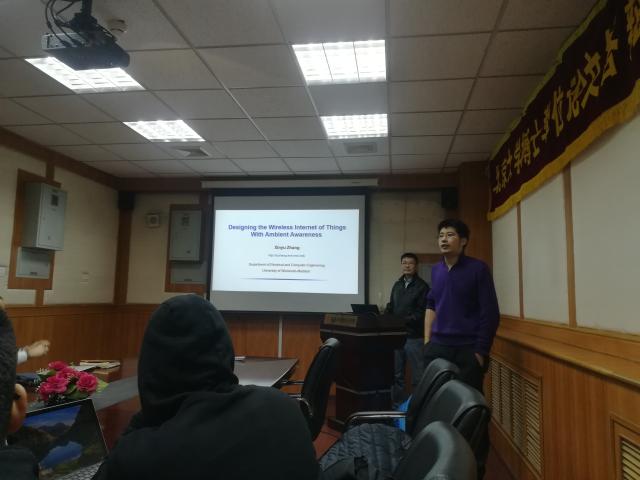2017年12月22日,美国加州大学圣地亚哥分校Xinyu Zhang博士来访中心,并做了“Designing the Wireless Internet of Things with Ambient Awareness”的报告。

ABSTRACT: The forthcoming decade will witness an explosion of Internet-of-Things (IoT), which incorporates not only the current mobile devices, but also smart everyday objects equipped with computation, communication and sensing capabilities. IoT will automate human life through a new wave of applications, such as smart buildings, intelligent connected vehicles, 3D user interfaces, and immersive telepresence. But to reach its tipping point, IoT still needs two critical foundations: (i) wireless network architectures that can scale to billions of devices with wire-speed connectivity; (ii) ubiquitous sensing mechanisms that enable the devices to be aware of ambient locations and micro-activities.
In this talk, I will present a common design principle to build these foundations. I will show that by designing proper computational models for wireless signals, we can obtain precise information about how wireless devices interact, with the environment and between themselves. The impacts of such computational intelligence manifest through two aspects: (i) Bridging the gap between the high theoretical capacity of wireless links and the poor application quality that users experience. Examples include scalable distributed MIMO and millimeter-wave networks with seamless coverage. (ii) Enabling ubiquitous sensing modalities that augment commodity wireless devices or plain objects with ambient intelligence. Examples include 3D orientation sensing of batteryless objects, decoding sound signals through wall using WiFi, and building-scale localization of smartphones at centimeter precision. From a broader perspective, these systems embody a fresh methodology to wireless systems research, which transcends the boundaries between signal processing, networking, and mobile computing.
BIOGRAPHY: Xinyu Zhang is an Associate Professor in the Department of Electrical and Computer Engineering at the University of California San Diego. Prior to joining UC San Diego, he was an Assistant Professor at the University of Wisconsin-Madison from 2012 to 2017. He received his Ph.D. degree from the University of Michigan in 2012. His research interest lies in wireless systems and ubiquitous computing, and more specifically in (i) designing next-generation wireless architectures based on millimeter-wave, large-scale distributed antennas, and physical-layer informed protocols; (ii) designing ubiquitous systems that leverage wireless signals to sense micro-locations and micro-activities at near-vision precision. His research work has been regularly published in top conferences in these areas, especially ACM MobiCom, MobiSys, USENIX NSDI, and IEEE INFOCOM. He is the recipient of ACM MobiCom Best Paper Award in 2011, NSF CAREER Award in 2014, and Google Research Award in 2017. His research has led to multiple tech transfers including a startup company specialized in visible light positioning. He served as the co-chair of NSF millimeter-wave research coordination network, TPC chair for the IEEE Conference on Sensing, Communication, and Networking (SECON) in 2017, and Associate Editor for IEEE Transactions on Mobile Computing since 2017.
点击此处下载海报。